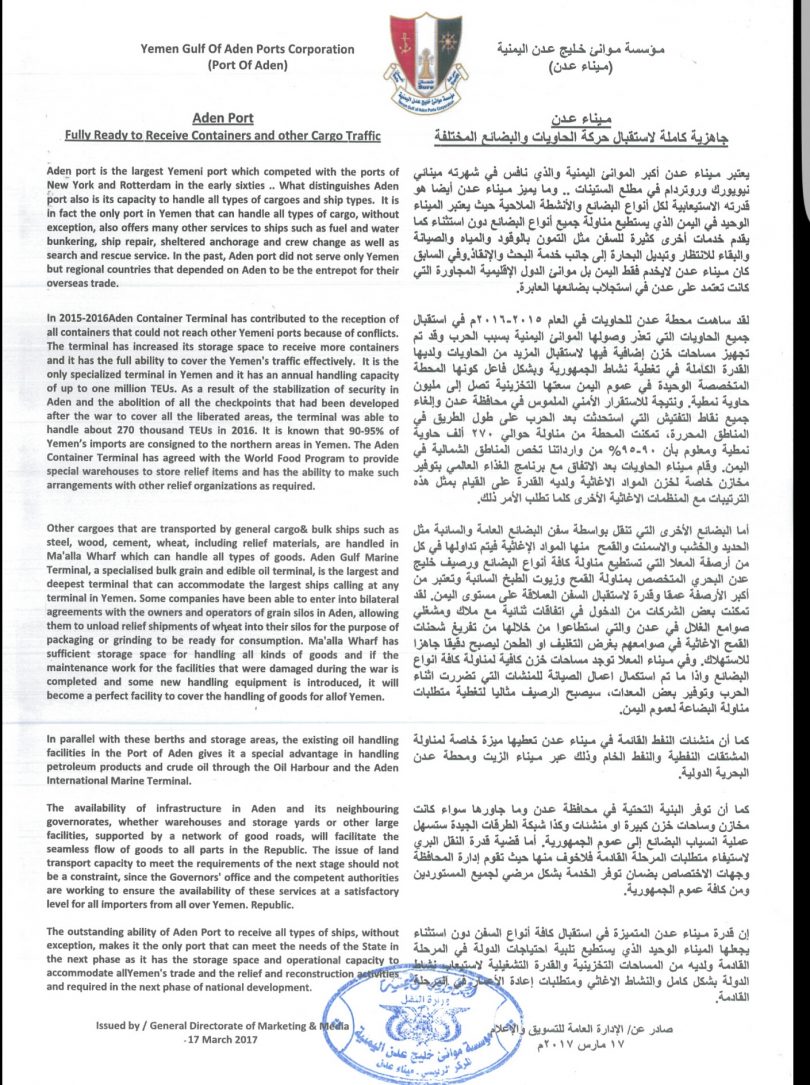The Yemen Gulf of Aden Ports Cooperation made a fresh statement saying that the port is fully ready to receive containers and other cargo traffic for commercial and humanitarian propose.
National Yemen obtained a copy of the statement, “ between 2015-2016 Aden container terminal received all containers that could not be lauded in any other Yemeni ports, due to the existing conflict, the terminal has updated extra space to receive commercial and humanitarian aids by the international organizations.
Yemen Gulf of Aden ports has taken a certain measure to ensure the safety, security and smooth delivery and recipient of all kind of shipments.
Aden has many advantages for shipping which helped to make it a regional distribution centre and will favour it in future:
It is directly on the main round-the-world and the Far East to Europe/America trade route, with a deviation of only 4 miles from this route to the pilot station;
It has clear approaches from waters 20-40 metres deep without reefs, is well-marked by aids to navigation, has clear weather, and a well-planned and easy channel four miles from fairway buoy to berth;
It provides deep water in one of the world’s largest natural harbours, protected from prevailing winds during winter months by 500 metres high hills to south and east, and from the summer SW monsoon by hills 350 metres high to the south west.
Aden is not only a container port. Other services have been provided in the past and will be provided in the future. Ship bunkering is an obvious example and there is considerable interest in expanding present facilities and developing new ones to offer in-harbour and offshore bunkering services.
Aden was declared a Free Port in 1850 as it took control of the coffee exporting trade. From 1869 the Suez Canal shortened the sea distance between London and Bombay from over 10,700 miles to 6,270 miles. Aden’s coal bunkering and re-provisioning trade accelerated. Aden was fortunate to be connected to the London/Bombay telegraph cable, giving it great advantages in east/west communications. By 1901, Aden’s inner harbour had been dredged to 30 feet to handle the largest ships of those days. In 1919 Aden introduced oil bunkering and became, by the 1950s, one of the world’s top bunkering ports, handling over 6,300 ships a year. When construction of the oil refinery and oil harbour was completed in 1954, Aden began to import and refine crude oil. Calls by cargo and passenger vessels made Aden the world’s fourth largest tax-free shopping port. It became the regional base for dhow, coastal, and deep-sea traffic. Dhows trading between the Gulf, Pakistan, the Red Sea and East Africa were regular callers and by mid-century Aden was handling over 1,500 dhows annually.







